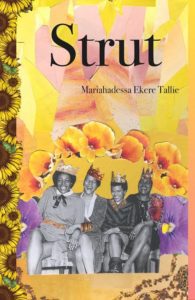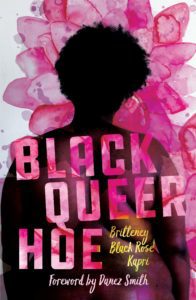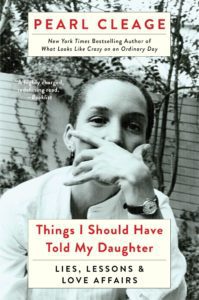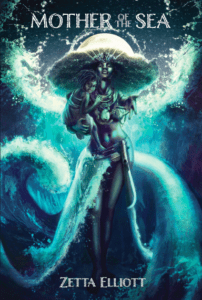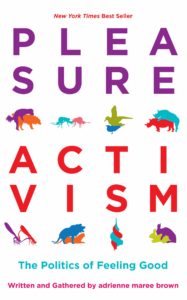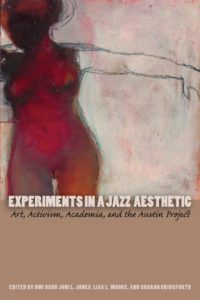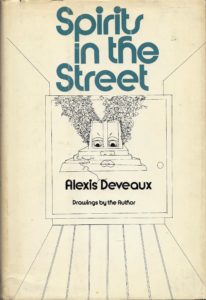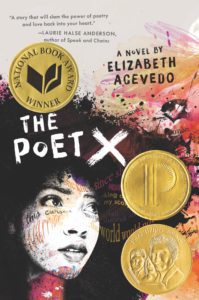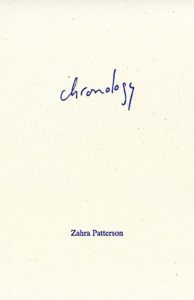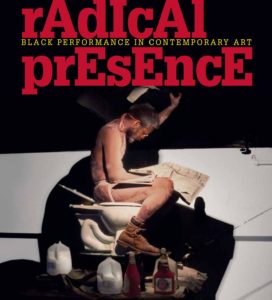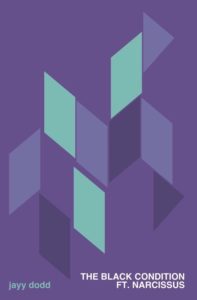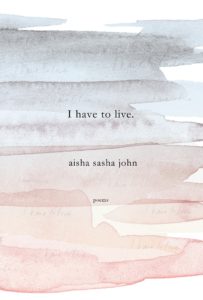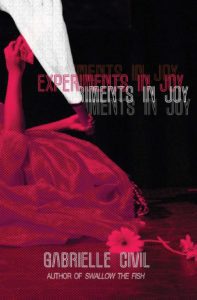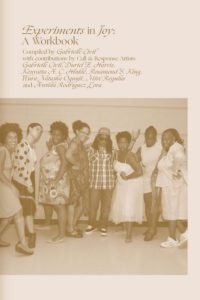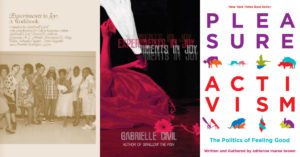
I remember how the paper turned blue. Not seeping, but arriving, saturating, and spreading. It wasn’t fire, but somehow it still seemed to burn. The chemistry set had shown up under the Christmas tree just for me! And, at nine years old, I loved the little white containers of chemicals, the test tubes, and the beakers. My first experiment was simple. Set something different on paper and encounter something new. A litmus test. A reaction. An experiment can be science, but it can be magic, too…
Years later, experiments continue to bring great magic to my life. At Antioch College in 2014, I convened Call & Response with six other black women artists: Duriel E. Harris, Kenyatta A. C. Hinkle, Rosamond S. King, Wura-Natasha Ogunji, Miré Regulus, and Awilda Rodríguez Lora. Our job was to collaborate on a Call, a collective prompt for artistic action. As we laughed, debated, and dreamed about what we wanted ourselves and our communities to do, joy made its way to the surface. We crafted a Call for everyone to conduct Experiments in Joy. This led to an Experiments in Joy festival and an outpouring of live art actions, dances, poetry, blog posts, and community projects that continue to this day.
Joy for us is not escaping reality but imagining something else. Centering joy as a practice, more than a feeling, helps counter the daily assault of our current, catastrophic political situation. To get started with your own experiment in joy, dive into the experiments of the black feminist literary tradition. Juicy, innovative, fierce, brilliant, experimental books by black women and femmes literally fill volumes. Ranging in style, tone, and genre and written by authors of different heritages, gender identities, and generations, the books listed here highlight various visions and approaches to joy. These are some of my favorite deep cuts and the list proceeds in order of our five steps for conducting an experiment in joy. Check them out, as well as the work of the original Call & Response artists mentioned above. Hopefully, these books and experimenting with joy will bring magic to your own life.
***
1. TELL THE TRUTH
Strut by Mariahadessa Ekere Tallie
A gift from my dear friend Rosamond S. King, Strut exudes black feminist joy! This bright and sensual collection offers haiku, blues and free verse poems about love, family, matrilineage, and more. From the book’s very first lines,” Ekere Tallie tells the truth: “Madness / runs in my family.” Even in the face of hardship, she asserts the healing power of creativity: “ I write my own / damn prescriptions.” Ekere Tallie honors black women’s tradition and marks her own place in it.
Black Queer Hoe by Britteney Black Rose Kapri
This book is funny and smart and sexy and honest AF. I first heard Kapri interviewed on the VS podcast with Franny Choi and Danez Smith and was immediately charmed by her swag. Billed as “a refreshing, unapologetic look at the line between sexual freedom and sexual exploitation,” this collection of poems also experiments with form and voice. Kapri uses cross outs, redactions, typography—and I love her tweets about Harriet Tubman! This book tells the truth about bodies, blackness, queerness, and desire.
Things I Should Have Told My Daughter: Lies, Lessons, & Love Affairs by Pearl Cleage
Much to my mother’s chagrin, I’m always nosy curious about black women who came before me. In Things I Should Have Told My Daughter, Cleage keeps it real and shares her journal entries from the 1970s and 1980s. Criminally under-recognized as a novelist and playwright, Cleage opens up about everything: her artistic aspirations, career anxieties, and political activism (working to elect Atlanta’s first black mayor)—not to mention her love life! She names names, tells the truth, and sets you in the middle of her world.
2. MAKE SOMETHING NEW
Mother of the Sea by Zetta Elliott
The tale of a black mermaid who destroys a slave ship, this novella for young readers definitely makes something new of our understanding of slavery. Never denying the horrors of the Middle Passage, Mother of the Sea shimmers with magic, invokes West African spirituality, and highlights agency, resistance, and black female power. Determined to produce and circulate high quality books for black youth, Elliott published this and other books on her own imprint. Self-publishing black feminist books is an experiment in joy we should all support.
Pleasure Activism: The Politics of Feeling Good by adrienne maree brown
If you think pleasure and activism are polar opposites, this book says think again. I haven’t read Pleasure Activism yet, but in the spirit of experimenting, it’s next on my list. I’m down for anything that asserts feeling good should be at the heart of our movements for justice. Invoking Audre Lorde’s “Uses of the Erotic,” and gathering the voices of her comrades, brown dares us to reclaim pleasure and make something new in our bodies and social systems. Book club, anyone?
Experiments in a Jazz Aesthetic: Art, Activism, and the Austin Project edited by Omi Osun Joni L. Jones, Lisa Moore, and Sharon Bridgforth
This book shows you how it’s done: it documents the Austin Project, a creative workshop for women of color and allies that started in Austin, TX in 2002. Led by Jones and Bridgforth and featuring acclaimed visiting artists like Laurie Carlos and Daniel Alexander Jones, the project inspired participants to create new writing and performance in the jazz aesthetic. This book archives their texts, explains their process, and celebrates the power of women of color making something new with art and community.
3. INVITE SOMEONE IN
Beyoncé in Formation: Remixing Black Feminism by Omise’eke Natasha Tinsley
Speaking of Austin, former University of Texas professor and Beyoncé super-fan Tinsley invites in Queen Bey, using her visual album Lemonade as an occasion to reveal and celebrate black queer femme culture in the South. A mixtape of music criticism, cultural studies, black “femme-inism” and juicy memoir, Beyoncé in Formation is accessible and compulsively readable. The Beyhive will ride with her breathless video analyses, but I especially love Tinsley’s candid stories about her own life and loves.
Spirits in the Street by Alexis De Veaux
Brimming with life, breath, honesty, and soul, Spirits in the Street is out of print—and it shouldn’t be. Focused on Harlem’s 114th Street, this book blurs the line between interior and exterior landscapes. De Veaux mixes and mingles character voices, typography, and original drawings. An underground classic of experimental black women’s writing, this book preserves the voice of De Veaux’s own girl self and the spirits around her. Find it in a library or secondhand store. Read it, then invite—no, demand—publishers bring this book back into print!
4. DOCUMENT
The Poet X by Elizabeth Acevedo
Remember what it was first like to try and document your life? This acclaimed YA novel pulses with heart as Xiomara claims her developing voice while pushing back on everyone’s fixation on her developing body. Drawing on her own experience as a Youth Slam poet champion Acevedo writes The Poet X in long lines of accessible verse. Root for Xiomara as she moves from the pages of her journal to the slam stage into the world. I laughed, I cried, I gobbled this book up!
Chronology by Zahra Patterson
A dossier of disparate documents, Chronology is one of those unique books that makes my heart skip a beat. A collection of emails, flyers, dictionary entries, images, and more, this book remembers Patterson’s friend, Liepollo Rantekoa, and comments on reading, travel, oral history, and more. Spare, witty and moving, Chronology also meditates on diaspora blackness, focusing on Southern African languages, literary cultures, and landscapes. Translating Sesotho becomes an experiment in joy as Patterson turns small acts of writing into souvenirs.
Radical Presence: Black Performance in Contemporary Art edited by Valerie Cassel Oliver
I remember walking through Radical Presence with deep joy in my heart. Yes! Senga Nengudi, David Hammonds, Lorraine O’Grady, and more. These were my people! This handsome catalogue documents Oliver’s acclaimed exhibit and the work of brilliant black performance artists across generations. While the book provides helpful essays on black performance art for context, the best part is the pictures. Looking at Nengudi’s panty hose sculptures, Hammonds selling snowballs, and O’Grady appearing as Mlle Bourgeoise Noire, you’ll itch to conduct your own experiment in joy.
5. REPEAT
The Black Condition ft. Narcissus by jayy dodd
Repetition ain’t nothing but the changing same. dodd brings back Narcissus with a (Miss) Major difference: flipping the script, remixing Greek mythology with trans femme blackness, queerness, and their own fierce intelligence. Returning again and again to Narcissus as a figure of self-adulation, bodily illusion and inquiry, dodd restates the black condition (“Black touch, touch Black, touching Black// to Black/ a Black touch/ a touch black”). They meditate on history. They beat the repeat in the body. They reset the future.
I have to live. by Aisha Sasha John
What is life anyway but a repetition of heartbeats and urges, thoughts, queries, and micro-escapades? Throughout it all, Aisha Sasha John repeats the mantra: I have to live. In “Regardless,” she writes: “If I coconut / If I’m crazy / If I’m coo-coo / If I’m weary / If I resist / If I’m easy / If I’m wrong / If I’m wrong-who gives a fuck? // I have to live.” If that doesn’t sum up the spirit of an experiment in joy, I don’t know what does. Enjoy!
And to close out this wonderful list, we just had to include Gabrielle’s memoir, Experiments in Joy, out now from The Accomplices, as well as Experiments in Joy: A Workbook, released today from Co-Conspirator Press! You can read an exclusive excerpt from Experiments in Joy here. – Ed.
Experiments in Joy by Gabrielle Civil
Experiments in Joy celebrates black feminist collaborations and solos in essays, letters, performance texts, scores, images, and more. Following her explosive debut Swallow the Fish, Civil now documents her work with From the Hive, No. 1 Gold, and Call & Response—whose collaborative Call inspired the title. The book also features her solo encounters with artists and writers, ancestors and audiences. Here you will find black girlhood, grief, ghosts, girls in their bedrooms, lots of books, dancing, reading, falling in love, fighting back, and flying. With lots of heart and the help of her friends, Civil keeps reckoning with performance, art, and life.
Experiments in Joy: A Workbook by Gabrielle Civil (with contributions by Call & Response Artists Gabrielle Civil, Duriel E. Harris, Kenyatta A. C. Hinkle, Rosamond S. King, Wura-Natasha Ogunji, Miré Regulus and Awilda Rodríguez Lora)
Experiments in Joy: A Workbook highlights the Call for Experiments in Joy, the transformative score produced by seven black women performers with different relationships to the words “black,” “woman,” and “performance.” A design project of the Women’s Center for Creative Work, this workbook offers brief reflections on the five-year anniversary of the Call by collaborators Gabrielle Civil, Duriel E. Harris, Kenyatta A. C. Hinkle, Rosamond S. King, Wura-Natasha Ogunji, Miré Regulus, and Awilda Rodríguez Lora. It also offers further resources and suggestions to conduct your own experiments in joy.

